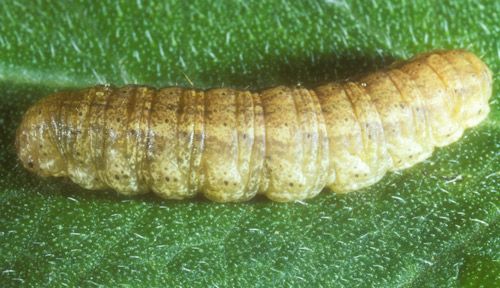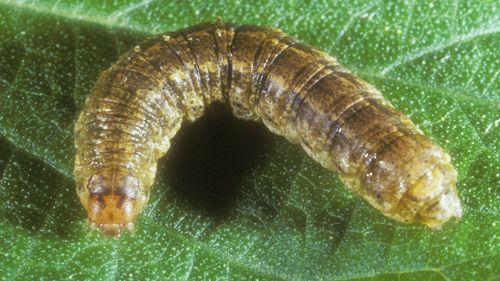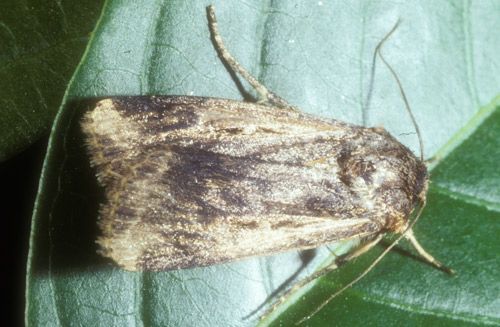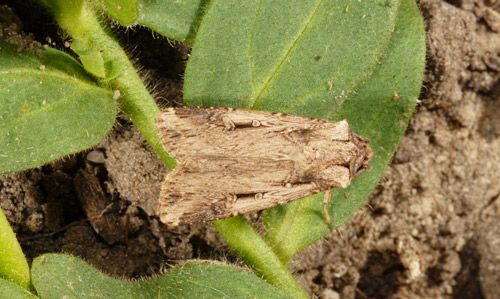The Featured Creatures collection provides in-depth profiles of insects, nematodes, arachnids, and other organisms relevant to Florida. These profiles are intended for the use of interested laypersons with some knowledge of biology as well as academic audiences.
Introduction
The granulate cutworm, Feltia subterranea (Fabricius) is the most commonly occurring cutworm in Florida, though it is rarely numerous enough to be a major pest. It is nocturnal through most of its life and lacks distinctive features in the larval and adult stage, so it often is overlooked, and its activities and damage are not fully appreciated.

Credit: Lyle J. Buss, UF/IFAS
Distribution
This species is native to the western hemisphere, and principally tropical in distribution. Although occasionally found as far north as the northern US and southern Canada, it appears not to breed at these latitudes. Also, it is not known from the northwestern US. It regularly occurs south of the Ohio River and occurs most frequently in the southernmost states from Georgia to California. It also occurs in Central and South America and the Caribbean.
Biology
Granulate cutworms can be found throughout the year in the south; adults, eggs, and larvae have been collected during all months in Louisiana and Florida. Nevertheless, there seems to be seasonality to reproduction, as unmated females are found mostly from May to November. In Florida, adults are most commonly collected in April to June, whereas in Louisiana they are most abundant from June to November. In Tennessee, three complete generations are reported, with moths emerging from overwintering pupae in March, but further south they are thought to breed almost continuously. In Tennessee, egg production becomes commonplace about March, with additional peaks in egg production in May, July, and September. The pupae from the September generation overwinter. The complete life cycle normally requires 50 to 70 days, depending on weather.
Biology is described by Jones (1918b), and Snow and Callahan (1968), with the most complete morphological description by Crumb (1929). Culture techniques are described by Lee and Bass (1969). Keys including the larva of this species are given by Crumb (1929, 1956), Whelan (1935), Okumura (1962), and Oliver and Chapin (1981).
Description
Eggs
Eggs are deposited singly or in small clusters on the upper surface of foliage. Females produce 800 to 1600 eggs. The eggs are hemispherical in shape, with 36 to 40 narrow ridges radiating from the apex, and measure 0.60 to 0.71 mm in diameter and about 0.50 mm in height. Initially they are white in color but darken with age. Normally they hatch in 3 to 5 days.
Larvae
Young larvae initially remain on the foliage during both day and night, but after a few days they begin to hide beneath plant debris or soil during the daylight hours, feeding only at night. The larva buries itself very shallowly, even remaining partially exposed during the day. The number of instars varies from 5–7, but 6 instars is most common.
Total larval development time is about 25 days for larvae with 6 instars, but 22 days for 5-instar larvae and 32 days for 7-instar larvae. Larvae with 6 instars consume about 150 sq cm of foliage but the longer-lived larvae that undergo 7 instars consume considerably more, up to 240 sq cm. This cutworm is grayish to reddish brown in color, with each abdominal segment bearing dull yellowish oblique marks subdorsally. A weak gray line occurs laterally below the spiracles, accompanied by spots of white or yellow. The head is yellowish to brownish in color.

Credit: John L. Capinera, UF/IFAS

Credit: John L. Capinera, UF/IFAS
Pupae
Pupation occurs in the soil, usually at a depth of 3 to 12 cm. The pupae are dark brown or mahogany in color, and measure 15 to 21 mm in length and 5 to 6 mm in width. Duration of the pupal stage is 10 to 20 days.
Adults
Moths begin mating about 1 day after emergence, and peak oviposition occurs 2 to 3 nights after mating (Snow and Callahan 1968, Cline and Habeck 1977). Longevity of adults is 10 to 20 days, averaging about 14 days. The moth is medium in size, with a wingspan of 31 to 43 mm. The color of the forewing varies considerably in its shades of brown and gray but is often yellowish brown and distinctly lighter distally. The forewing bears distinct bean-shaped and round spots centrally, and these spots are linked by a small but sharply defined black bar. The hind wings are white, but dusky marginally and along the veins.

Credit: John L. Capinera, UF/IFAS
Economic Importance
This is the most important cutworm pest of vegetables in the Gulf Coast region, and also quite important in California. It damages seedlings by cutting off the stem at the soil surface, older plants by climbing and feeding on foliage, and injures such plants as tomato, watermelon, and eggplant by feeding on, or burrowing into, the fruit. Due to its surface-feeding behavior, granulate cutworm is sometimes a major component of the "rindworm" complex affecting cucurbit fruit. This type of damage usually occurs when fruit are in contact with soil, a common habitat of the larva. Young larvae, through about the second instar, feed on the lower leaf surface and skeletonize leaves. Thereafter, they consume entire leaves.

Credit: Lyle J. Buss, UF/IFAS
Granulate cutworm feeds on a wide range of plants. Among vegetables attacked are bean, beet, broccoli, Brussels sprouts, cabbage, carrot, cauliflower, celery, corn, cowpea, eggplant, kale, lettuce, onion, pea, pepper, potato, radish, spinach, sweet potato, tomato, turnip, and watermelon. Other crops reported injured include alfalfa, clover, cotton, lespedeza, peach, peanut, sorghum, soybean, strawberry, tobacco, vetch, and wheat. Some of the weeds that support larvae are thorny amaranth, Amaranthus spinosus; cocklebur, Xanthium sp.; dandelion, Taraxacum sp.; passion vine, Passiflora incarnata; plantain, Plantago sp.; and shepherdspurse, Capsella bursa-pastoris. Eggs are sometimes found on cotton and mistaken for the more serious cotton bollworm, Helicoverpa zea (Boddie) and tobacco budworm, Heliothis virescens (F.) (Bryan et al. 2000), so it is useful to differentiate them, thereby perhaps eliminating an unnecessary treatment.
Management
Moth populations can be monitored with blacklight traps. Larvae can be controlled by application of insecticides delivered as liquid, granule, or bait formulation. Baits, particularly bran-based baits, seem particularly effective (Morgan and French 1971). Many cutworm species have a great affinity for weedy fields, but granulate cutworm seems to lack this association. Mechanical barriers can provide some protection from dispersing larvae to seedlings in the home garden. However, moths are often active during the growing season and easily circumvent such barriers. Therefore, it may also be necessary to use netting or row cover material to deny access to plants by ovipositing moths.
Considering the importance of this cutworm in southern states, surprisingly little is known about natural enemies. Among the wasps known to parasitize granulate cutworm are Apanteles griffini Viereck, Chelonus insularis Cresson, Meteorus laeventris (Wesmael), Meteorus laphygmae Viereck, Microgaster feltiae Meusebeck, Zele mellea (Cresson) (all Hymenoptera: Braconidae), Campoletis flavicincta (Ashmead) and Simphion merdarius (Gravenhorst) (both Hymenoptera: Ichneumonidae). Fly parasitoids known from this cutworm include Bonnetia comta (Fallen), Gonia crassicornis (Fabricius), Gonia longipulvilli Tothill, Lespesia archippovora (Riley), and Spallanzania hebes (Fallen) (all Diptera: Tachinidae). A microsporidian disease was reported from Florida (Adlerz 1975) and a granulosis virus is known (Hamm and Lynch 1982), but the importance of natural pathogens is uncertain.
Selected References
Adlerz WC. 1975. "Natural control of three rindworm species and chemical control of the granulate cutworm, Feltia subterranea on watermelon." Proceedings of the Florida State Horticulture Society 88:204–207.
Bryan W, Sutula CL, Adamczyk JJ Jr., Adams LC, Hardee DD, Brown RL, Davis FM, Harris AF, Robbins JT, Price B Jr., Edwards M, Miller T, LaMasters T, Kimbrough J. 2000. Incidence of the granulate cutworm, Feltia subterranea (F.) (Lepidoptera: Noctuidae) in early season Mississippi cotton: an example of the utility of a heliothine egg identification system (Hel-ID) in IPMProceedings of the Beltwide Cotton Conference, 2000. Vol. 2. pp. 1004–1006.
Cline LD, Habeck DH. 1977. "Reproductive biology of the granulate cutworm." Journal of the Georgia Entomological Society 12:34–41.
Crumb SE. 1929. "Tobacco cutworms." USDA Technical Bulletin 88. 179 pp.
Crumb SE. 1956. "The larvae of the Phalaenidae." USDA Technical Bulletin 1135. 356 pp.
Hamm JJ, Lynch RE. 1982. "Comparative susceptibility of the granulate cutworm, fall armyworm, and corn earworm to some entomopathogens." Journal of the Georgia Entomological Society 17:363–369.
Jones TH. 1918. "The granulated cutworm, an important enemy of vegetable crops in Louisiana." USDA Bulletin 703:7–14.
Lee BL, Bass MH. 1969. "Rearing technique for the granulate cutworm and some effects of temperature on its life cycle." Annals of the Entomological Society of America 62:1216–1217.
Okumura GT. 1962. "Identification of lepidopterous larvae attacking cotton with illustrated key (primarily California species)." California Department of Agriculture Bureau of Entomology Special Publication 282. 80 pp.
Oliver AD, Chapin JB. 1981. "Biology and illustrated key for the identification of twenty species of economically important noctuid pests." Louisiana Agricultural Experiment Station Bulletin 733. 26 pp.
Morgan LW, French JC. 1971. "Granulate cutworm control in peanuts in Georgia." Journal of Economic Entomology 64:937–939.
Snow JW, Callahan PS. 1968. "Biological and morphological studies of the granulate cutworm, Feltia subterranea (F.) in Georgia and Louisiana." Georgia Agricultural Experiment Station Bulletin 42. 23 pp.
Whelan DB. 1935. "A key to the Nebraska cutworms and armyworms that attack corn." University of Nebraska Agricultural Experiment Station Research Bulletin 81. 27 pp.